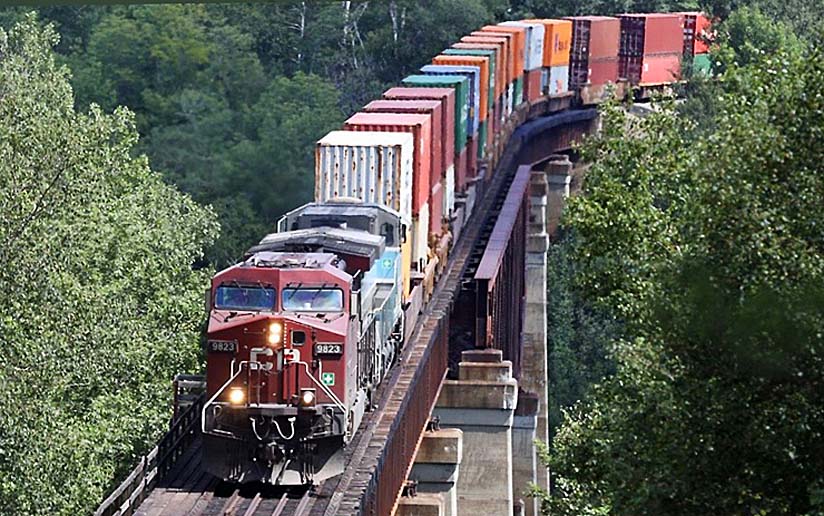

Saint John New Brunswick - "The Big Shift," an article in the October 2020 issue of Trains, is an in-depth look at the shift of
international intermodal traffic from the U.S. West Coast to ports on the U.S. East Coast and Gulf Coast, as well as to ports in Western Canada.
Canadian Pacific (CP), which serves the Port of Vancouver, has benefited from this trend, as British Columbia ports have increasingly become gateways to the
U.S. Midwest.
Now CP is aiming to develop transatlantic international intermodal traffic via the Port of Saint John, New Brunswick, via its acquisition of the Central Maine
& Quebec (CMQ), which formed much of its historic shortcut between Montreal and the Atlantic.
Trains spoke with Jonathan Wahba, CP's vice president of sales and marketing for intermodal and automotive, about these trends and what they mean for
CP.
Q: Over the past decade, shippers have begun to take a so-called four corners approach to importing cargo to North America. The expanded Panama Canal has
opened, making it more attractive to ship containers via an all-water route to the East Coast. Manufacturing has risen in Southeast Asia, making the Suez Canal
a competitive way to reach the East Coast. How are these trends affecting CP's intermodal volume?
A: In a word, they've been favorable to us. And we look at our service today out of Vancouver, it's pretty hard to beat our transit times into Chicago,
regardless of whatever gateway you're coming from, either north or south of us. Take our Precision Scheduled Railroading turnaround story with Hunter Harrison
and Keith Creel showing up at CP in 2012 and 2013, couple that with our shorter road miles, and focus on PSR, and we've really developed a service that has
appealed to Beneficial Cargo Owners, or BCOs.
Q: Vancouver container volumes are up nearly 60 percent in the past decade. Do you see that growth slowing, or do you see continued share shift from U.S.
ports?
A: COVID-19 aside, if we just look for the broader trend, I would say we at CP are quite optimistic that this share shift up through the Vancouver gateway will
continue. And if you look at the two significant expansion projects, one just completed at Deltaport, and one now fully under way at Centerm, we see today's
current capacity of Vancouver at about 4.1 million TEUs. And five years from now, we'll be at just under 5 million TEUs of capacity. Deltaport, for the first
time in many years, has excess capacity to sell with their semi-autonomous terminal expansion done. Can Vancouver handle that type of growth? The answer's yes.
And if I look at CP in our network and our inland terminals, we have the room to grow as well. In the case of CP, north of 40 percent of the cargo that
discharges on the import side of Vancouver is destined for the United States. In Montreal, at the other end of the network, we're at 50 percent. BCO's like the
speed, they probably like the economics related to the U.S. Harbor Maintenance Tax (which Canada lacks). So if you're a high-value goods importer, apparel,
auto parts, there are economic advantages to be had. So we think that combination can keep growing.
Q: Right now the Port of Saint John is focused on north-south trade with the Caribbean, Latin America, and South America. Is there an opportunity for the Port
of Saint John to tap into imports from Europe and from Southeast Asia that transit the Suez Canal and the Atlantic to reach North America?
A: Absolutely. So our acquisition of the CMQ will give us haulage access for the first time in a quarter of a century to the Atlantic coast. We are incredibly
excited. This is a very real and a very substantial business opportunity for CP. By and large, this is a diamond in the rough of a terminal. And if you think
about the attributes of the terminal, it's run by DP World. So we've got a great global operator in place. There's deep water access, and the large vessels
that supports. And then our routing is 200 miles shorter than our competitor's coming out of Halifax. Their best day and our best day, those 200 miles it's
more than half a day of transit time advantage we're going to have getting into Montreal, Toronto, Detroit, Chicago, and the U.S. So it's something we're very
excited about. Our goal is to increase the container ship business at the Port of Saint John and really that is what we are squarely focused on right now. We
believe we can put together an attractive package with DP World to attract a transatlantic service.
Train's editor's note: CP this month began hauling international containers from the Port of Saint John due to the ongoing strike at the Port of
Montreal, which has diverted ships to Saint John.
Q: It's not every day you get to create an essentially new container port from scratch, right? The port's already there, but it's not really living up to its
full potential right now.
A: It's not an exaggeration still to say this is a once-in-a-generation opportunity for our company. The interesting thing about this is that a number of
people inside CP within our executive team went through this drill 13 or so years ago with another port in a small place that people hadn't heard of on the
other side of the continent (Prince Rupert, British Columbia, served by Canadian National). We see an opportunity here to do something special in Saint
John.
Q: Do you think there's enough volume to go around when you look at all the different ways the shippers are getting into the Midwest? That seems to be the big
draw here, right? To get to all those consumers in Chicago, Detroit, Minneapolis, as well as Southern Ontario. There are advantages to coming in from the West.
There are advantages to coming in from the East. How do you see that all shaking out?
A: Great question. And I would answer it this way. You know, CP would not have spent $130 million buying the CMQ if we didn't have great conviction and
confidence that we will be able to attract significant traffic. The leadership team at CP has felt for some time that we were at a competitive disadvantage by
not having deep water access on the Atlantic coast. That's why we're so excited about this opportunity. And it's so unique. We just wouldn't have gone down
this path if we didn't have the conviction that we can replicate the service model we've created in other places.
Bill Stephens.
(because there was no image with original article) *2. Original news article image replaced.
(usually because it's been seen before)
provisions in Section 29 of the Canadian
Copyright Modernization Act.
